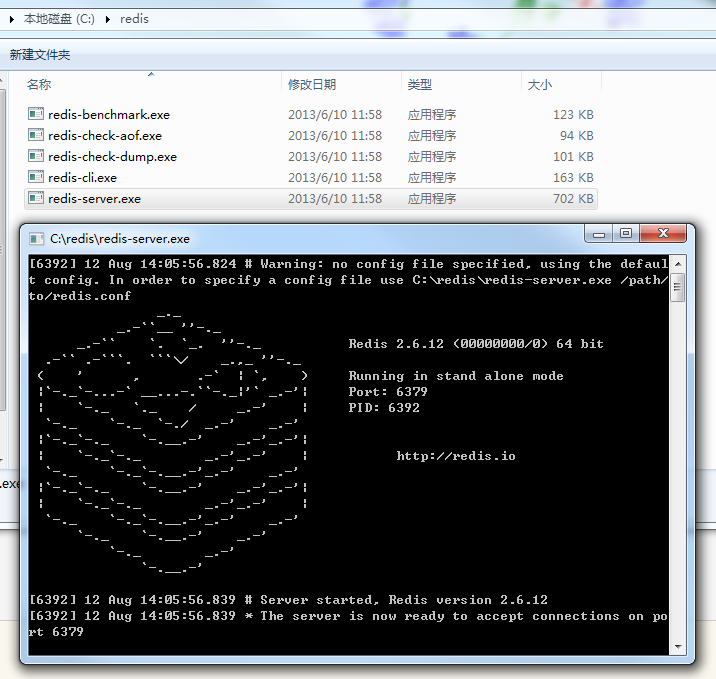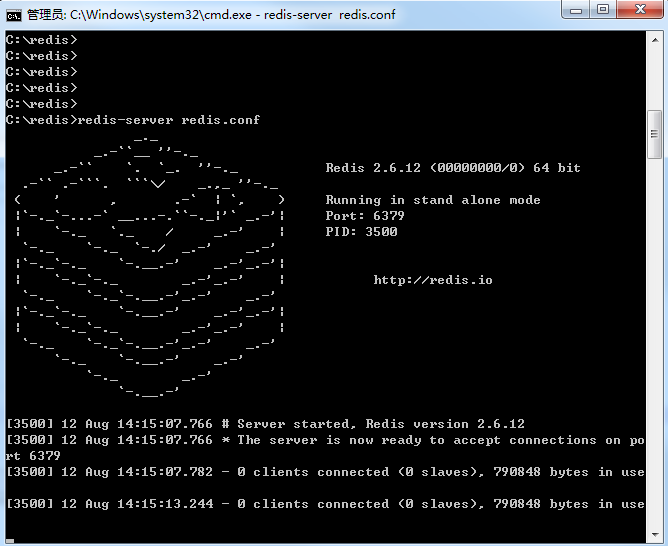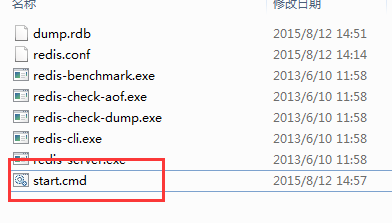1、redis之安装与配置
下载安装:

redis-server.exe redis服务器的daemon启动程序
redis.conf redis配置文件
redis-cli.exe redis命令行操作工具。当然,也可以用telnet根据其纯文本协议来操作
redis-check-dump.exe 本地数据库检查
redis-check-aof.exe 更新日志检查
redis-benchmark.exe 性能测试,用以模拟同时由N个客户端发送M个 SETs/GETs 查询 (类似于 Apache的 ab 工具)
上面是使用默认的config来启动redis,如果需要修改默认配置可以在redis的根目录下建立redis.conf文件,内容参考:
# Redis configuration file example # By default Redis does not run as a daemon. Use 'yes' if you need it.
# Note that Redis will write a pid file in /var/run/redis.pid when daemonized.
daemonize no # When run as a daemon, Redis write a pid file in /var/run/redis.pid by default.
# You can specify a custom pid file location here.
pidfile /var/run/redis.pid # Accept connections on the specified port, default is
port # If you want you can bind a single interface, if the bind option is not
# specified all the interfaces will listen for connections.
#
# bind 127.0.0.1 # Close the connection after a client is idle for N seconds ( to disable)
timeout # Set server verbosity to 'debug'
# it can be one of:
# debug (a lot of information, useful for development/testing)
# notice (moderately verbose, what you want in production probably)
# warning (only very important / critical messages are logged)
loglevel debug # Specify the log file name. Also 'stdout' can be used to force
# the demon to log on the standard output. Note that if you use standard
# output for logging but daemonize, logs will be sent to /dev/null
logfile stdout # Set the number of databases. The default database is DB , you can select
# a different one on a per-connection basis using SELECT <dbid> where
# dbid is a number between and 'databases'-
databases ################################ SNAPSHOTTING #################################
#
# Save the DB on disk:
#
# save <seconds> <changes>
#
# Will save the DB if both the given number of seconds and the given
# number of write operations against the DB occurred.
#
# In the example below the behaviour will be to save:
# after sec ( min) if at least key changed
# after sec ( min) if at least keys changed
# after sec if at least keys changed
save
save
save # Compress string objects using LZF when dump .rdb databases?
# For default that's set to 'yes' as it's almost always a win.
# If you want to save some CPU in the saving child set it to 'no' but
# the dataset will likely be bigger if you have compressible values or keys.
rdbcompression yes # The filename where to dump the DB
dbfilename dump.rdb # For default save/load DB in/from the working directory
# Note that you must specify a directory not a file name.
dir ./ ################################# REPLICATION ################################# # Master-Slave replication. Use slaveof to make a Redis instance a copy of
# another Redis server. Note that the configuration is local to the slave
# so for example it is possible to configure the slave to save the DB with a
# different interval, or to listen to another port, and so on.
#
# slaveof <masterip> <masterport> # If the master is password protected (using the "requirepass" configuration
# directive below) it is possible to tell the slave to authenticate before
# starting the replication synchronization process, otherwise the master will
# refuse the slave request.
#
# masterauth <master-password> ################################## SECURITY ################################### # Require clients to issue AUTH <PASSWORD> before processing any other
# commands. This might be useful in environments in which you do not trust
# others with access to the host running redis-server.
#
# This should stay commented out for backward compatibility and because most
# people do not need auth (e.g. they run their own servers).
#
# requirepass foobared ################################### LIMITS #################################### # Set the max number of connected clients at the same time. By default there
# is no limit, and it's up to the number of file descriptors the Redis process
# is able to open. The special value '' means no limts.
# Once the limit is reached Redis will close all the new connections sending
# an error 'max number of clients reached'.
#
# maxclients 128 # Don't use more memory than the specified amount of bytes.
# When the memory limit is reached Redis will try to remove keys with an
# EXPIRE set. It will try to start freeing keys that are going to expire
# in little time and preserve keys with a longer time to live.
# Redis will also try to remove objects from free lists if possible.
#
# If all this fails, Redis will start to reply with errors to commands
# that will use more memory, like SET, LPUSH, and so on, and will continue
# to reply to most read-only commands like GET.
#
# WARNING: maxmemory can be a good idea mainly if you want to use Redis as a
# 'state' server or cache, not as a real DB. When Redis is used as a real
# database the memory usage will grow over the weeks, it will be obvious if
# it is going to use too much memory in the long run, and you'll have the time
# to upgrade. With maxmemory after the limit is reached you'll start to get
# errors for write operations, and this may even lead to DB inconsistency.
#
# maxmemory <bytes> ############################## APPEND ONLY MODE ############################### # By default Redis asynchronously dumps the dataset on disk. If you can live
# with the idea that the latest records will be lost if something like a crash
# happens this is the preferred way to run Redis. If instead you care a lot
# about your data and don't want to that a single record can get lost you should
# enable the append only mode: when this mode is enabled Redis will append
# every write operation received in the file appendonly.log. This file will
# be read on startup in order to rebuild the full dataset in memory.
#
# Note that you can have both the async dumps and the append only file if you
# like (you have to comment the "save" statements above to disable the dumps).
# Still if append only mode is enabled Redis will load the data from the
# log file at startup ignoring the dump.rdb file.
#
# The name of the append only file is "appendonly.log"
#
# IMPORTANT: Check the BGREWRITEAOF to check how to rewrite the append
# log file in background when it gets too big. appendonly no # The fsync() call tells the Operating System to actually write data on disk
# instead to wait for more data in the output buffer. Some OS will really flush
# data on disk, some other OS will just try to do it ASAP.
#
# Redis supports three different modes:
#
# no: don't fsync, just let the OS flush the data when it wants. Faster.
# always: fsync after every write to the append only log . Slow, Safest.
# everysec: fsync only if one second passed since the last fsync. Compromise.
#
# The default is "always" that's the safer of the options. It's up to you to
# understand if you can relax this to "everysec" that will fsync every second
# or to "no" that will let the operating system flush the output buffer when
# it want, for better performances (but if you can live with the idea of
# some data loss consider the default persistence mode that's snapshotting). appendfsync always
# appendfsync everysec
# appendfsync no ############################### ADVANCED CONFIG ############################### # Glue small output buffers together in order to send small replies in a
# single TCP packet. Uses a bit more CPU but most of the times it is a win
# in terms of number of queries per second. Use 'yes' if unsure.
# glueoutputbuf yes # Use object sharing. Can save a lot of memory if you have many common
# string in your dataset, but performs lookups against the shared objects
# pool so it uses more CPU and can be a bit slower. Usually it's a good
# idea.
#
# When object sharing is enabled (shareobjects yes) you can use
# shareobjectspoolsize to control the size of the pool used in order to try
# object sharing. A bigger pool size will lead to better sharing capabilities.
# In general you want this value to be at least the double of the number of
# very common strings you have in your dataset.
#
# WARNING: object sharing is experimental, don't enable this feature
# in production before of Redis 1.0-stable. Still please try this feature in
# your development environment so that we can test it better.
# shareobjects no
# shareobjectspoolsize 1024
然后使用redis.conf启动redis:

为了方便起见,建议建立一个start.cmd文件,里面输入如下内容:
redis-server redis.conf

1、redis之安装与配置的更多相关文章
- [Linux]Linux下redis的安装及配置.
在上一篇[Linux] linux下安装配置 zookeeper/redis/solr/tomcat/IK分词器 详细实例. 我们已经将redis所需tar包拷贝到了linux下的root 根目录下, ...
- Redis的安装、配置 --转载
原文地址:http://blog.sina.com.cn/s/blog_505bf9af0101ehhp.html redis的安装.配置 安装步骤如下:下载redis安装包:$ cd /opt/ap ...
- Redis:安装、配置、操作和简单代码实例(C语言Client端)
Redis:安装.配置.操作和简单代码实例(C语言Client端) - hj19870806的专栏 - 博客频道 - CSDN.NET Redis:安装.配置.操作和简单代码实例(C语言Client端 ...
- mac与centos下redis的安装与配置
前言 最近在用redis,下面简单写一下mac和centos下redis的安装与配置方法. 安装 mac下面 安装命令:brew intall redis 运行命令:brew services sta ...
- 最新版redis的安装及配置 linux系统
1.redis下载 官网地址:https://redis.io/download 百度云地址:链接:http://pan.baidu.com/s/1c1Hu2gK 密码:h17z 2.解压 [root ...
- c#连接Redis Redis的安装与配置
Redis是一个不错的缓存数据库,读取数据速度效率都很不错.今天大家共同研究下redis的用法.结合网上的资料和自己的摸索,先来看下安装与配置把. 咱们主要看在WINDOWS上怎样使用REDIS数据库 ...
- centos6.8下redis的安装和配置
centos6.8下redis的安装和配置 下载.安装 在redis官网可以获取到最新版本的redis 进入/usr/local/目录,执行如下命令 wget http://download.redi ...
- linux下redis的安装及配置启动
linux下redis的安装及配置启动 标签: redisnosql 2014-10-24 14:04 19732人阅读 评论(0) 收藏 举报 分类: 数据与性能(41) wget http:/ ...
- windows上redis的安装和配置
windows上redis的安装和配置 进入到Redis的根目录D:\Programming\Redis\Redis6379\Redis-x64-3.2.100底下操作: 配置文件启动 redis-s ...
- 莫小安 Linux下Redis的安装与配置
转载自--Linux下Redis的安装与配置 redis是当前比较热门的NOSQL系统之一,它是一个key-value存储系统.和Memcached类似,但很大程度补偿了 memcached的不足,它 ...
随机推荐
- MySQL数据库事务各隔离级别加锁情况--read uncommitted篇(转)
本文转自https://m.imooc.com/article/details?article_id=17291,感谢作者 1.目的 1.1 合适人群 1.数据库事务特征我只是背过,并没有很深刻的理解 ...
- powerdesigner 设置字段显示comment注释
在Columns标签下,一排按钮中找到这个按钮:Customize Columns and Filter
- MySql 数据库导入"Unknown command '\n'."错误解决办法
原文地址:http://www.cnblogs.com/bingxueme/archive/2012/05/15/2501999.html 在CMD 下 输入: Mysql -u root -p -- ...
- .NET:CLR via C# Exceptions and State Management
重点学习的个概念 unhandled exceptions constrained execution regions code contracts runtime wrapped exception ...
- Android Binder 设计与实现 - 设计篇
关键词 Binder Android IPC Linux 内核 驱动 摘要 Binder是Android系统进程间通信(IPC)方式之一.Linux已经拥有管道,system V IPC,socket ...
- winform禁用标题栏
protected override void WndProc(ref Message m) { if (m.Msg == 0x112) { switch ((int)m.WParam) { //禁止 ...
- 前端新手如何安装webstorm ,初步搭建react项目
下载安装webstorm:配置成功: 配置成功后就可以开启webstorm项目了.(存微信收藏..) 1:在webstorm下配置node环境: 2:完成之后: React官方脚手架地址: https ...
- sql的嵌套查询,把一次查询的结果做为表继续进一步查询;内联视图
Mysql的嵌套表查询 嵌套SELECT语句也叫子查询,一个 SELECT 语句的查询结果能够作为另一个语句的输入值.子查询可以: 出现在Where子句中, 出现在from子句中,作为一个临时表使用, ...
- [leetcode]Binary Tree Maximum Path Sum @ Python
原题地址:https://oj.leetcode.com/problems/binary-tree-maximum-path-sum/ 题意: Given a binary tree, find th ...
- 搭建个人博客-hexo+github
自己也算是摸爬滚打搭建成功,然后自己再重新安装部署一遍,把完整步骤分享给大家,同时最后有一些连接,如果我的步骤不行,大家可以参考其他人的(这个有点花费时间,大家提前有个心理准备 - _-) 一.第一步 ...
